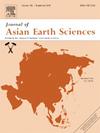演化夕卡岩体系中的钴矿化:来自磁海铁钴矿床共含矿物的启示
IF 2.4
3区 地球科学
Q2 GEOSCIENCES, MULTIDISCIPLINARY
引用次数: 0
摘要
钴是一种重要的金属,通常是矽卡岩型铁矿的副产品。了解此类矿床中含钴矿物及其富集成因,对资源有效利用和矿产勘查具有重要意义。以中国西北慈海矽卡岩型铁矿为例,对这一问题进行了解析。在该矿床中,铁矿体与辉长岩杂岩和夕卡岩蚀变有关。分立的钴矿物包括钴矿、六重辉石矿、菱铁矿和斜菱辉石矿,其中以六重辉石矿分布最广。钴主要富集在黄铁矿中,浓度可达1.4 wt%,在磁黄铁矿中略有富集(45-67 ppm),在黄铜矿中可以忽略不计。高分辨率原子探针层析成像分析发现,富Co黄铁矿中存在Co纳米团簇,形成于Co非均相取代Fe的过程中。磁海矿床中Co的富集与岩浆热液作用有关。富钴流体可能是流体对基性岩的淋滤作用产生的。此外,热液演化过程中磁铁矿的广泛结晶进一步促进了Co的富集。温度和氧逸度在这一过程中起次要作用。提出了三阶段Co成矿模型。在渐进夕卡岩阶段,钴与石榴石和辉石相结合。逆行矽卡岩阶段,磁铁矿结晶作用使Co富集于流体中。在硫化物阶段,Co在黄铁矿和Co矿物中析出。该研究强调了流体组成及其演化在控制夕卡岩体系中Co成矿作用中的重要意义。本文章由计算机程序翻译,如有差异,请以英文原文为准。
Cobalt mineralization in an evolving skarn system: Insights from co-bearing minerals in the Cihai Fe-Co deposit, NW China
Cobalt is a critical metal and is usually a by-product in many skarn Fe deposits. Understanding Co-bearing minerals and origin of Co enrichments in such deposits is essential for both efficient resource utilization and mineral exploration. The Cihai skarn Fe deposit in northwestern China is well known to contain considerable amounts of Co and is taken as an example to decipher this issue. In this deposit, Fe orebodies are associated with diabase-gabbro complexes and skarn alteration. Discrete Co minerals include cobaltite, siegenite, ferroskutterudite, and clinosafflorite, with siegenite being the most widespread. Cobalt is mainly enriched in pyrite, reaching concentrations of up to 1.4 wt%, and is slightly enriched in pyrrhotite (45–67 ppm) and is negligible in chalcopyrite. High-resolution atom probe tomography analysis identifies Co nanoclusters within Co-rich pyrite, formed through the heterogeneous substitution of Fe by Co. The enrichment of Co in the Cihai deposit is attributed to magmatic-hydrothermal processes. The Co-rich fluids are likely generated through leaching of mafic rocks by fluids. Moreover, the extensive crystallization of magnetite during hydrothermal evolution further contributes to Co enrichment. Temperature and oxygen fugacity play minor roles in this process. A three-stage Co mineralization model is proposed. In the prograde skarn stage, Co is incorporated into garnet and pyroxene. In the retrograde skarn stage, Co is enriched in fluids due to magnetite crystallization. In the sulfide stage, Co precipitates in pyrite and Co minerals. This study underscores the significance of fluid composition and evolution in controlling Co mineralization in the skarn system.
求助全文
通过发布文献求助,成功后即可免费获取论文全文。
去求助
来源期刊

Journal of Asian Earth Sciences
地学-地球科学综合
CiteScore
5.90
自引率
10.00%
发文量
324
审稿时长
71 days
期刊介绍:
Journal of Asian Earth Sciences has an open access mirror journal Journal of Asian Earth Sciences: X, sharing the same aims and scope, editorial team, submission system and rigorous peer review.
The Journal of Asian Earth Sciences is an international interdisciplinary journal devoted to all aspects of research related to the solid Earth Sciences of Asia. The Journal publishes high quality, peer-reviewed scientific papers on the regional geology, tectonics, geochemistry and geophysics of Asia. It will be devoted primarily to research papers but short communications relating to new developments of broad interest, reviews and book reviews will also be included. Papers must have international appeal and should present work of more than local significance.
The scope includes deep processes of the Asian continent and its adjacent oceans; seismology and earthquakes; orogeny, magmatism, metamorphism and volcanism; growth, deformation and destruction of the Asian crust; crust-mantle interaction; evolution of life (early life, biostratigraphy, biogeography and mass-extinction); fluids, fluxes and reservoirs of mineral and energy resources; surface processes (weathering, erosion, transport and deposition of sediments) and resulting geomorphology; and the response of the Earth to global climate change as viewed within the Asian continent and surrounding oceans.
 求助内容:
求助内容: 应助结果提醒方式:
应助结果提醒方式:


